A table without carp. Kutia without honey. And fish ... in Yiddish. In the difficult years of the war, you could not count on twelve Christmas Eve dishes. But our (great) grandmothers were able to create Christmas out of nothing to the truth anyway!
The first Christmas dinner under the occupation was not as poor as it might seem. The supplies collected in advance allowed us to create a substitute for real Christmas. It was only in the following years that the dishes became more and more modest and modest. So much so that the ubiquitous in everyday life also crept into the preparations for the Christmas Eve supper. Few people could afford to eat their fill with the meanest bread, not to mention preparing a Christmas supper full of delicacies.
Before the war, in many homes it was a celebration for the whole family, with a richly set table, a Christmas tree glowing with dozens of candles and lots of gifts. Many housewives, who recently celebrated just like this, did not know how to adjust to the new reality. They had just lived in a comfortable, multi-room flat, had servants and a full pantry ... Now they were thrown from a beautiful flat into some poor one-room cubicle, the maid had left her job a long time ago and successfully traded on the black market, and in order to get supplies, we had to sell the leftover jewelry .
Fortunately for such women, during the war, very useful cookbooks began to be published showing how to feed the family at a low cost. Their authors did not ignore the issue of holidays. Being aware of the everyday worries of the housewives, in their publications they published provisions that corresponded to the difficult reality of the war.
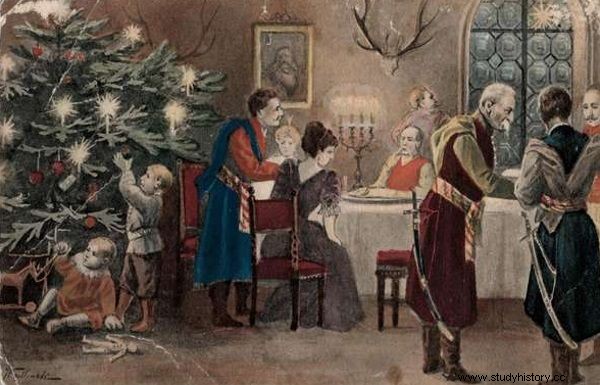
Sumptuous Christmas Eve, like the one from the 19th-century Polish postcard, had to be forgotten.
Holidays are almost here and the preparations are raging in our homes. Before we unload the cart to the brim with food again in a crazy rush around the supermarket or discount store, maybe it is worth taking a moment to reflect.
Instead of spending a fortune on ingredients that will end up in the bin without being eaten two days after Christmas, it's better to think about how our whips dealt with the preparation of the Christmas Eve menu in times of crisis. And possibly - take an example from them. We present a few suggestions straight from the book by Elżbieta Kiewnarska from 1940.
Pure mushroom broth with dumplings (6-8 people)
For the stock we need:4 decagrams of dried mushrooms, vegetables (2 carrots, 2 onions, 1 parsley, 1 leek, a piece of celery), a few peppercorns, bay leaf, salt to taste. On ears (this is the term Kiewnarska uses) take 20 decagrams of flour, 6 decagrams of butter, lard or good oil, two tablespoons of millet or Krakow groats, baking powder, 1 egg, salt to taste.
Boil a decoction of mushrooms, vegetables, allspice and bay leaf in three liters of water. Take out the mushrooms, chop them finely and mix them with the cooked groats. Chop the onion, fry in 2 decagrams of fat and mix with the groats and mushrooms, sprinkle with a tablespoon of flour, pour a few tablespoons of broth, boil, salt and season with pepper to taste, set aside to cool.
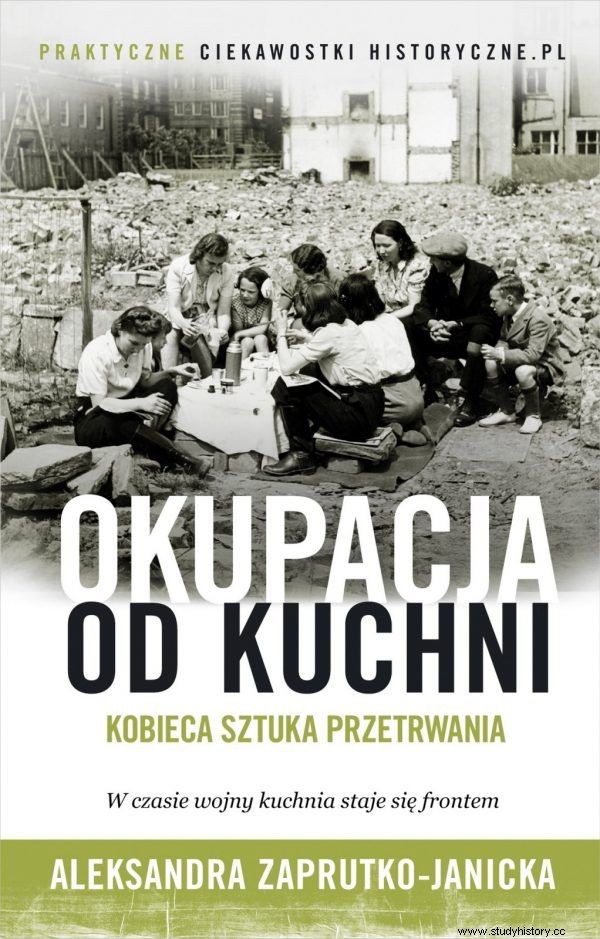
The female art of survival in Aleksandra Zaprutko-Janicka's book "Occupation from the kitchen". Click and buy with a discount on empik.com .
Use the remaining flour, egg, water and a little salt to knead the dough. We roll it out, spread it on one side with the remaining melted fat and fold it twice. We repeat the action four times. Roll it out thinly, cut into squares, put a small amount of stuffing in the middle and stick it together in the handle. Place the glued dumplings in a baking tray and bake them until golden brown. As Kiewnarska writes: Serve it very hot with an equally hot soup. Do not put them in the plates until eating soup. They are delicious, crispy. When they get soft, they lose their flavor.
Suszenina (serving for 6-8 people)
Rinse 25 decagrams of dried fruit (apples, pears and plums) and soak overnight in cold water with a few tablespoons of sugar. The next day, cut the fruit and boil it in the same water in which it was soaked until it is completely soft.
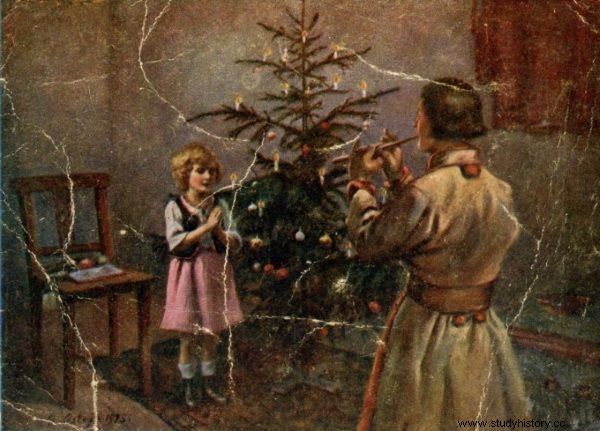
Under the occupation, Poles longed for Christmas with Christmas trees shining with candles and singing Christmas carols. Instead, they lived in constant fear for their own safety.
Add a few cloves and a piece of cinnamon bark to the pot. Spread a heaped tablespoon of potato flour in cold water and pour it over the boiling fruit, bring to a boil, then set aside to cool. Sweeten with saccharin to taste.
Jewish-style stuffed fish from small fish (for 10-12 people)
We need a kilogram of small fish, 5 onions, 15 decagrams of breadcrumbs, 15 decagrams of boiled potatoes, 2 large eggs or 3-4 raw potatoes, pepper, salt and allspice.
This article has more than one page. Please select another one below to continue reading.Attention! You are not on the first page of the article. If you want to read from the beginning click here.
Stuffed fish is traditionally prepared from large fish, such as carp. During the war, for most people, they were either too expensive or difficult to obtain. Hence, instead, small fish such as smelt. It is also worth paying attention to the name of the dish. For the mere accusation of ties with Jews during the war, one could end up in a camp, and yet the Jewish carp still bore its name!
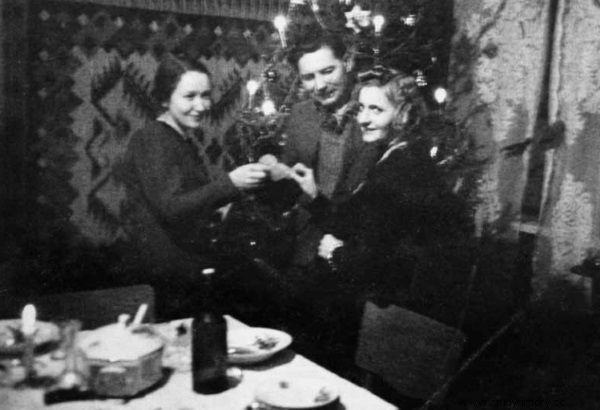
Despite the growing poverty and hopelessness, Poles did not give up celebrating holidays. It was that little normal for them to keep their senses healthy.
To prepare the dish, grind the fish in a meat grinder together with the onion, soaked and squeezed roll and boiled potato dumplings. Put the ground mass on a pastry board and chop it, mixing it with a glass of ice water or… snow. When the mass becomes smooth, add the eggs, and if we do not have them, grate raw potatoes, salt, season with pepper (preferably white) and mix again. Take a scalded cloth, smear it with oil or lard and put the stuffing on it, then roll it up, tie it and sew it together. Put the prepared mixture into the boiling broth and cook slowly for an hour from the moment it boils again. 'Stuffed fish' can be served warm or sliced cold.
Mint gingerbreads
We need 3 glasses of flour, ¾ glass of water, half a teaspoon of powdered ammonia, half a glass of sugar, 12 drops of peppermint oil.
First, all the ingredients need to be kneaded together. After that, however, Kiewnarska recommends something unusual.

The female art of survival in Aleksandra Zaprutko-Janicka's book "Occupation from the kitchen". Click and buy with a discount on empik.com .
Instead of rolling out the dough and cutting out the biscuits, we have to make balls the size of a small walnut and place it on a baking tray dusted with flour. Bake the balls, which at this time grow quickly until they are golden brown.
Christmas Kutja
We need 25 decagrams of wheat grains, 20 decagrams of poppy seeds, sugar or saccharin to taste.
Soak the wheat overnight in cold water and cook the next day. We scald the poppy seeds and leave them in the water overnight. The next day, it should be drained and ground in a meat grinder (fine mesh) and mixed with cooked wheat. Sweeten to taste.
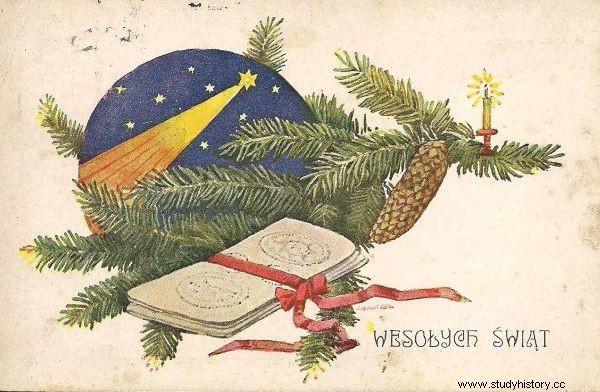
These few of the most basic recipes show how poor Christmas Eve was at that time. No delicacies, exquisite fish, honey, butter and other delicacies. If we want to sit down to a really traditional dinner, it is better to follow the example of our grandmothers, and not the colorful newspaper trying to convince us that the more the better.
Recipe Source:
Elżbieta Kiewnarska, 109 dishes , Warsaw 1941.
